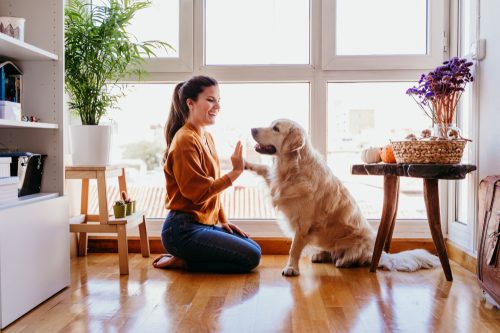Dogs Cry With Joy When Their Owners Return Home, New Study Reveals
It turns out we might actually be dog's best friend, too.

The deep bond between dogs and humans has been well-documented throughout history. It's widely believed that King Frederick of Prussia was the first person to refer to these canine companions as "man's best friend," when he praised the unrivaled loyalty of his greyhound in the 1700s. And our love for dogs has only grown since. In June, Gucci introduced its first-ever luxury collection for pets, which includes a $7,500 dog bed and $460 poop bag holder. Over in the U.K., there's been a rising trend in people pampering their pups with spa treatments and facials. But fortunately, the intense love we feel for our dogs is not one-sided. A new study shows that our dogs likely love us as much as we love them—so much so, in fact, that they cry tears of joy when we return home to them. Read on for the scientific proof of this canine connection.
READ THIS NEXT: The 7 Best Dogs for Beginners, Vets Say.
Dogs are the most owned pet in the U.S.

Americans love their dogs—and that's an understatement. According to a report from the American Veterinary Medical Association (AVMA), they are by far the most owned pet in the U.S., with nearly 50 million homes across the country having at least one dog. But pooches are more than just pets to many of us. In 2019, a survey conducted by SpotOn found that 98 percent of all dogs owners nationwide consider their dogs to be members of the family. That same year, a different study from Merrick and Harris Poll revealed that 7 out of 10 pet parents in the U.S. even go so far as to say that their dog is their favorite member of the family.
"From the time we bring home a puppy that is a furry bundle of joy, dogs become part of our families," Mary Burch, animal behaviorist and director of the American Kennel Club's Canine Good Citizen program, told PetMD. "They grow up with our children, move through phases of our lives with us … and when it comes time to tell them goodbye for the last time, we mourn over them just as we would human family members."
Now, science has shown that this fervent love is reciprocated by our canine companions.
A new study highlights the intense bond between dogs and their owners.

Let's be honest: Most of us would still give all our love to our dogs even if they didn't love us back. But fortunately, the bond we feel with our furry family members is likely mutual. Japanese researchers from Azabu University and Jichi Medical University recently sought to shed insight into the special bond between dogs and humans. Their study, which was published in the Current Biology journal on Aug. 22, analyzed the different reactions of 22 dogs when they were reunited with their owners compared to when they were reunited with people they knew but who were not their owners.
The researchers placed specialized strips of paper under the eyes of dogs to use as tear markers. According to the study, a dog's tear product increased "significantly" in the first five minutes of their owners returning home after five to seven hours of separation. This same increase was not observed when they were reunited with other familiar people who were not their owners.
"We had never heard of the discovery that animals shed tears in joyful situations, such as reuniting with their owners, and we were all excited that this would be a world first," Takefumi Kikusui, one of authors of the study, said in a statement.
RELATED: For more up-to-date information, sign up for our daily newsletter.
Scientists say this is likely linked to a specific hormone.

This reaction during the reunion of a dog and its owner is likely linked to the hormone oxytocin, according to the researchers. "Oxytocin is a hormone that's produced in the hypothalamus and released into the bloodstream by the pituitary gland," Harvard Health explains, noting that it's commonly produced in higher levels during childbirth or displays of affection—which is why it is often referred to as the "love drug" or "love hormone."
Kikusui said his research started six years ago after he noticed tears in the eyes of one of his poodles who had just given birth and was nursing the puppies. "That gave me the idea that oxytocin might increase tears," he said. According to the researcher, a dog's tears don't fall as they often do when humans cry, but you can still see unmistakable tears in a dog's eyes. As part of the study, he and his researchers found that the dogs' tear volume also increased when they added oxytocin to their eyes—supporting the idea that the release of oxytocin plays a role in the tears produced by dogs when they reunite with their owner.
"We found that dogs shed tears associated with positive emotions. We also made the discovery of oxytocin as a possible mechanism underlying it," Kikusui confirmed.
Experts say there are ways you can strengthen the bond between you and your dog.

The relationship developed been dogs and humans "has always been a special and reciprocal one," Andy Ramshaw, a dog expert and owner of Venture Dog Training in Donegal, Ireland, tells Best Life. But in order to receive the kind of love that has your dog crying when you return home, reciprocation is the key. In other words, you can't just expect to be bonded with your dog if you do nothing to foster that bond.
"Just like with human relationships, the more you put into understanding and meeting the needs of your dog, the more they will appreciate you and the deeper your bond will grow," Alexandra Bassett, the owner and lead trainer at Dog Savvy Los Angeles, explains.
This can be done in different ways, of course. "These days our bond with our dogs is based on love and affection. Dogs lives center around rewards and what they can do to get the most, best rewards," Ramshaw says. "Those rewards can be food or drink. They can also be in the form of games, activities, places or situations. Using this landscape of available rewards to teach our dogs builds a relationship and trust."





















